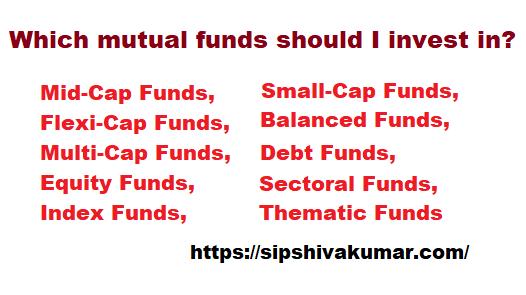Start Mutual funds SIP, call:9886568000
Investing in mutual funds is a popular choice for both new and seasoned investors looking to diversify their portfolios, manage risk, and achieve long-term financial goals. The mutual fund market offers a variety of fund types, each catering to different investment strategies and risk appetites. This article explores the key types of mutual funds available in 2024, providing insights into large-cap funds, mid-cap funds, small-cap funds, flexi-cap funds, balanced funds, multi-cap funds, and debt funds, along with examples to help guide your investment decisions.

Mutual fund returns are subject to market conditions, please read the offer document before investing.
1. Large-Cap Funds
Overview: Large-cap funds invest in companies with large market capitalizations, typically well-established firms with a solid track record of performance. These companies are leaders in their industries, offering stability and lower volatility compared to smaller companies.
Investment Strategy: Ideal for conservative investors seeking steady returns with lower risk, large-cap funds focus on blue-chip stocks known for their resilience during market downturns.
Example: The HDFC Top 100 Fund is a notable example, consistently delivering stable returns due to its investment in top-tier companies across various sectors.
2. Mid-Cap Funds
Overview: Mid-cap funds invest in medium-sized companies, which fall between large-cap and small-cap in terms of market capitalization. These companies are typically in their growth phase, offering a balance between stability and growth potential.
Investment Strategy: Suitable for investors willing to take on moderate risk for higher returns, mid-cap funds provide a mix of growth and stability, making them a good option for long-term growth.
Example: The Axis Midcap Fund is well-regarded for its robust performance, focusing on companies with strong growth potential and sound management.
3. Small-Cap Funds
Overview: Small-cap funds target smaller companies with high growth potential. These companies are often in the early stages of development and can deliver substantial returns, albeit with higher risk.
Investment Strategy: Best suited for aggressive investors with a high-risk tolerance and a long-term investment horizon, small-cap funds can be highly rewarding but are also susceptible to market volatility.
Example: The SBI Small Cap Fund has shown impressive performance, capitalizing on emerging businesses with strong growth trajectories.
4. Flexi-Cap Funds
Overview: Flexi-cap funds have the flexibility to invest across market capitalizations—large-cap, mid-cap, and small-cap—based on the fund manager’s discretion. This allows for dynamic asset allocation in response to market conditions.
Investment Strategy: These funds are ideal for investors looking for a diversified portfolio with the potential for optimized returns across different market segments.
Example: The Parag Parikh Flexi Cap Fund is known for its adaptive strategy, investing in high-potential companies regardless of their market cap.
5. Balanced Funds
Overview: Balanced funds, also known as hybrid funds, invest in a mix of equities and debt instruments. This blend aims to provide both growth and income, balancing the risk and return.
Investment Strategy: Suitable for moderate investors seeking a balanced approach, these funds offer stability through debt investments while capturing equity market gains.
Example: The HDFC Balanced Advantage Fund effectively combines equity and debt investments to deliver consistent returns with lower volatility.
6. Multi-Cap Funds
Overview: Multi-cap funds invest across all market capitalizations, maintaining a diversified portfolio that includes large-cap, mid-cap, and small-cap stocks. This diversification helps mitigate risks associated with any single segment.
Investment Strategy: Ideal for investors seeking broad market exposure and diversified risk, multi-cap funds provide a balanced investment across various market segments.
Example: The Kotak Standard Multicap Fund is well-regarded for its comprehensive approach, investing in a variety of companies to achieve diversified growth.
7. Debt Funds
Overview: Debt funds invest primarily in fixed-income securities such as bonds, treasury bills, and other debt instruments. These funds are generally lower in risk compared to equity funds, providing stable and predictable returns.
Investment Strategy: Best for conservative investors seeking capital preservation and regular income, debt funds are less volatile and offer a safer investment avenue.
Example: The ICICI Prudential Corporate Bond Fund is a standout in this category, focusing on high-quality corporate bonds to deliver steady income with low risk.
Choosing the Right Mutual Fund – Which mutual funds should I invest in?
When deciding where to invest in mutual funds, consider the following factors:
- Risk Tolerance: Understand your risk appetite. Large-cap and debt funds are suitable for conservative investors, while small-cap and mid-cap funds cater to those willing to take on more risk.
- Investment Horizon: Align your investment choices with your time frame. Short-term investors might prefer debt funds, while long-term investors can explore equity-oriented funds for higher growth potential.
- Financial Goals: Define your financial goals clearly. Whether you aim for wealth accumulation, regular income, or capital preservation, there is a mutual fund type that suits your needs.
- Market Conditions: Stay informed about market trends and economic conditions. Flexi-cap and multi-cap funds are advantageous in volatile markets due to their dynamic asset allocation.
The mutual fund landscape in 2024 offers a wide range of options to cater to diverse investment needs and preferences. Whether you’re a conservative investor seeking stability, an aggressive investor chasing high returns, or someone in between, there is a mutual fund tailored for you. By understanding the characteristics and strategies of large-cap, mid-cap, small-cap, flexi-cap, balanced, multi-cap, and debt funds, you can make informed decisions that align with your financial goals and risk tolerance.
For those looking to capitalize on high-growth opportunities, small-cap funds like the SBI Small Cap Fund provide significant potential, albeit with higher risk. Meanwhile, investors seeking stability might prefer the HDFC Top 100 Fund or ICICI Prudential Corporate Bond Fund, which offer steady returns with lower volatility.
Ultimately, the key to successful mutual fund investing lies in thorough research, understanding your financial objectives, and choosing the right mix of funds to create a well-rounded and resilient investment portfolio.
Which mutual funds should I invest in? whatsapp or call to start sip, 9886568000



